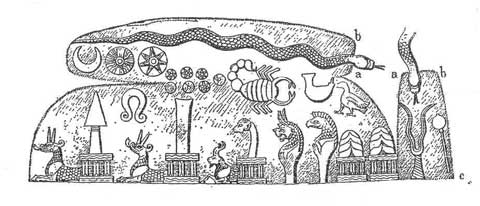Digression on Berossus and the Babyloniaca, Continued
“Finally, there was no justification for Schwartz’ assumption that Berossus borrowed the doctrine of the Great Year from Greek philosophy. As P. Schnabel protested in 1923, Berossus‘ belief in a coming conflagration corresponded exactly to his lengthy account of a past Deluge, the two catastrophes marking the Great Year’s solstices in Cancer and Capricorn. There is to-date no evidence that the Great Year originated in Greek philosophy, and so no reason why it should be denied to the scholars of Babylon.
I do not know where Berossus published his statements about the Great Year and other astrological and astronomical matters. Since, however, no work other than his Babyloniaca is attested, it was most likely in one of the three books of that work that these subjects were discussed.
Berossus could have touched on these matters in Book Two. He did say that “in the tenth generation after the Deluge there was among the Chaldaeans a great and just man, skilled in celestial matters”, and the likely provenance of that Fragmentum is Book Two.

I have been unable to source the origin of this illustration, which resembles the Boundary Stone of Ritti-Marduk, British Museum No. 90,858, in so many details. It is possible that the illustration is a modern artifice, integrating components from the Boundary Stone, which is dated to the reign of Nebuchadnezzar I, circa 1120 BCE. The subject matter is obviously the Babylonian zodiac.
If you locate the source of this illustration, please advise me so that I may update this page.
Along the top is stretched a serpent, signifying the constellation Hydra. Beneath its tail is the inverted crescent of the Moon God Sin, the Four-Pointed Star or rosette of Shamash, the Sun God, and the Eight-Pointed Star of Ishtar. Celestial figures, seven in number, perhaps illustrating the cosmos as understood by the Babylonians of that era, are followed by the Scorpion, which is opposite the Zodiacal Bull in Taurus, not depicted.
The remaining features in the lower register exceed my scholarship, which is meager. If you can interpret them, I would be grateful for assistance. I observe that the composite creatures in the lower register are seven in number, perhaps corresponding to the chthonic creatures associated with Tiamat. It also occurs to me that they may portray the great temples of the gods in their various cities and cult centers.
I found this illustration on this page:
http://www.google.co.th/imgres?imgurl=http://www.redicecreations.com/specialreports/2006/01jan/annunaki10.jpg&imgrefurl=http://pixshark.com/babylonian-zodiac.htm&h=206&w=480&tbnid=UtiwYm8SfNjwcM:&zoom=1&docid=BJ1iXAxTrNnHSM&ei=mTA9VbaUIILJuATc7YBA&tbm=isch&ved=0CCgQMygJMAk
The link below is to the Boundary Stone of Ritti-Marduk.
http://www.britishmuseum.org/research/collection_online/collection_object_details/collection_image_gallery.aspx?partid=1&assetid=135127&objectid=369364
But I think it even more likely that the astrological doctrines came at the end of the third book. Berossus disposed of the last four kings of the Neo-Babylonian dynasty in a few paragraphs, and did not allot much more than that to Nabopolassar and Nebuchadnezzar. One wonders what filled the rest of Book Three.
Semiramis‘ importance was denied. We shall presently see what Berossus had to say about Sennacherib and his successors, and here note only that it was not much; and Frag. 10 suggests that he did little more than list the regnal periods of the Persian rulers of Babylon.
If, like most, a book of the Babyloniaca ran to c. 2000 lines, almost two thirds of the book remains unaccounted for. I suggest that here, constituting about a quarter of the whole work, was to be found the “astronomy and philosophical doctrines of the Chaldaeans”, the presentation of which secured for Berossus whatever reputation he did enjoy in the classical world.
Such, I would argue, was the nature of the Babyloniaca. It has been customarily considered a work of history, and I do not doubt that it was presented as such: if they do not refer to it as the Babyloniaca, ancient authors call it the Chaldiaca, the Chaldaean History, or the History of the Chaldaeans.
The only thing in it which was of value to Josephus and Eusebius was what Berossus had to say about the history and chronology of Babylon in post-diluvian times, and it is as an historian that Berossus has been classified for the last 1500 years.
But in Hellenistic and Roman times, when his work was still known, the subjects with which Berossus was identified were “astronomy and the philosophical doctrines of the Chaldaeans”.
No matter how his work is reconstructed, what is conventionally called history can be made to fill little more than a third of it. It is no wonder that Pliny the Elder reports that the Athenians set up a statue of Berossus “ob divinas praedicationes“; and that in Judaea there grew a legend that the name of the Sibyl’s father was Berossus, a legend no more improbable than its modern equivalent, that of “Pseudo-Berossus of Cos”.”
Robert Drews, “The Babylonian Chronicles and Berossus,” Iraq, Vol. 37, No. 1 (Spring, 1975), pp. 52-4.
